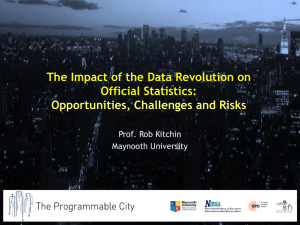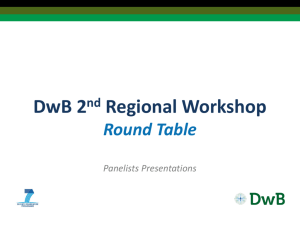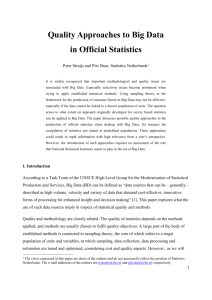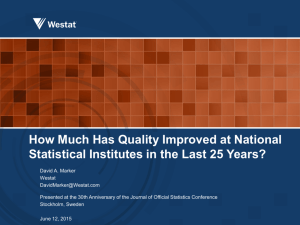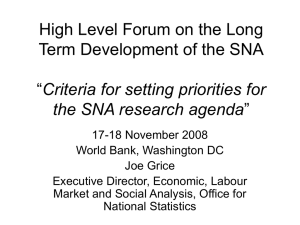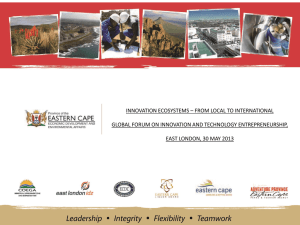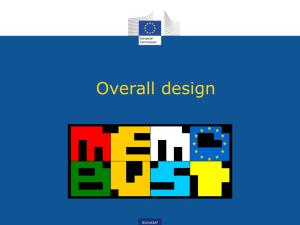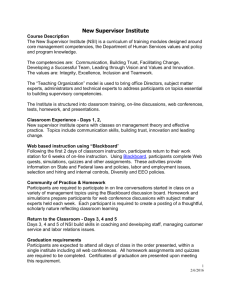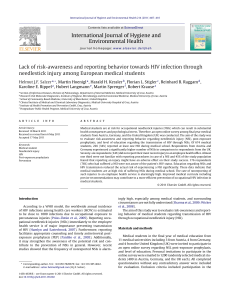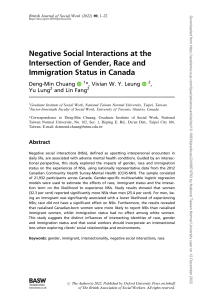Modernisation of Statistics Production Summary and Conclusions New York 24 February 2010
advertisement
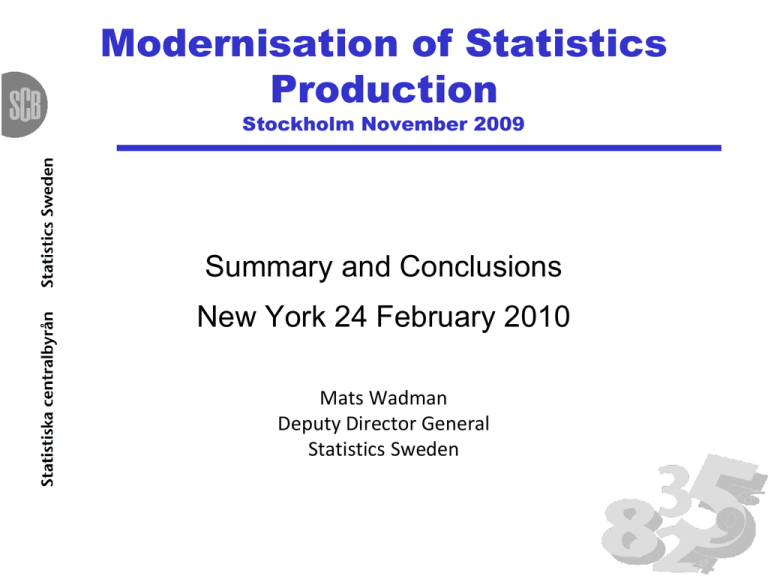
Modernisation of Statistics Production Stockholm November 2009 Summary and Conclusions New York 24 February 2010 Mats Wadman Deputy Director General Statistics Sweden Reasons for organizing a conference on Modernisation of Statistics Production • We all face an increased demand for new accurate and timely data. • At the same time pressure to reduce costs. • There is a broad understanding that we have to focus our efforts to enhance efficiency, cost effectiveness, and quality. • That a key aspect of this is to successfully standardise the production process. • Need for more improved collaboration between agencies. • Striving for a uniform perception of quality. The topics of the sessions 1. 2. 3. 4. 5. The role of the customer in statistics production. Quality assurance systems. Service-oriented architectures. Management of processes and resources. Collection and use of paradata in statistics production. 6. Innovations in data collection and design. 7. Optimal use of registers and administrative data. 8. Generic business models and standardised processes. Main findings from conference Standardisation of processes Learning and sharing Organizational issues Leadership and culture Customer orientation Quality Organizational issues • Knowing what users need. • Striving for excellence - Identify world-class approaches. • Adopting the process view. Henry Ford : “We will not put into our establishment anything that is useless.” • Developing standards and operating procedures. • Creating a culture of continuous improvement. • Check process variation by means of paradata and control charts. Customer orientation (1) Our statistics must be based on the needs of the customers. • Customers demand more and more tailor-made statistics and quick information about upcoming trends that require a large degree of adaptability from the NSIs. • If NSIs are unable or slow in reacting to new demands, someone else will react instead. Competition in the information market is quickly increasing. • NSI:s must be able to respond to new needs of customers, but still handle continuity. • NSIs must focus on the customer needs without letting the image of the NSI be damaged. • Maintaining the scientific approach. Customer orientation (2) • Not everything is possible to produce, NSI must be able to explain the restrictions without losing the confidence of the customers. • Build trust in statistics. • NSIs must also consider to provide more accompanying analysis to increase the value of the data. But maintaining the objective and impartial perspective. • We need to reduce response burden e.g. by re-use survey data, use administrative data. Customer orientation (3) • Seek partners that can help make statistics available using new media. • I.e. Intermediaries such as Google or Bloomberg can help in meeting customers needs, using NSI data and making them available in new forms. • Developing reports with users. Customer orientation (4) • Metadata needs to be available for customers to judge the quality of statistics and the available outputs. • Metadata is important in a language and format that is understood by customers. NSIs have not yet come far in describing “fitness for purpose” and this is an area where more research is needed. • Find out how users work with information on quality. The importance of using quality frameworks • To get good product quality we need to consider the way we do thing i.e., process quality. • To achieve good product quality we need to consider organisational issues such as leadership and strategic planning i.e., organizational quality. • We need to consider the way we carry out our production process since it will affect product quality. – quality frameworks such as ISO 9001 or EFQM can help us work in a systematic way with improvements. Leadership and culture • Strong leadership and strong commitment in leadership is important. – targets must be measurable. – Management must also engage in the follow-up of implementation. • A general agreement that a step by step approach is preferable to balance change against the ongoing activities of the organisation. NO BIG BANG. • Standards and guidelines is absolutely essential or much resources are wasted. Leadership and culture (2) • It seems that culture in statistical agencies often is an obstacle to change. • Involvement of the staff is absolutely essential. • Top management must be able to explain changes in a language that is understood across the organisation in order for change to gain momentum. • Good examples of implementation of new methods and approaches in statistics production to justify further approaches. Picking the right projects to start with is a strategic decision. • Follow-up and evaluate. Learning and sharing (1) NSIs can and must learn from each other • Technology is developing fast. One NSI can't cover all aspects. • We all face an increased demand for new data. At the same time pressure to reduce costs. • Agencies are not competitors and Most problems are shared. • Cooperation and sharing work is the only way that NSIs will be able to keep up with this development and make efficient use of the new possibilities. Can we do our IT-systems more homogeneous? • Benchmarking is a good alternative to cooperation. • Work in smaller constellations on urgent matters that people care about and want to engage in. Learning and sharing (2) • Nothing can be successfully compared unless the information, e.g. paradata, is standardised (much can be improved) • There are too many areas of cooperation, focusing is key. • One important area of cooperating is training and development of competence. • The use of administrative data especially between countries necessitates a large degree of standardisation to ensure comparability. Learning and sharing (3) • A lack of methodology for use of administrative data. • What the are the roles of NSIs and universities. • NSIs have to take the lead in developing methodology and effective use of administrative data. Processes • Develop standardized processes. • Define key quality indicators. • Check process variation by means of paradata and control charts. • Improve processes when needed e.g., selective editing. • Build paradata data banks. To sum up There are strong links between standardisation of processes, learning and sharing, organisational culture and leadership, customer orientation, and quality. Use a step by step approach. NO big bang. Thank you

